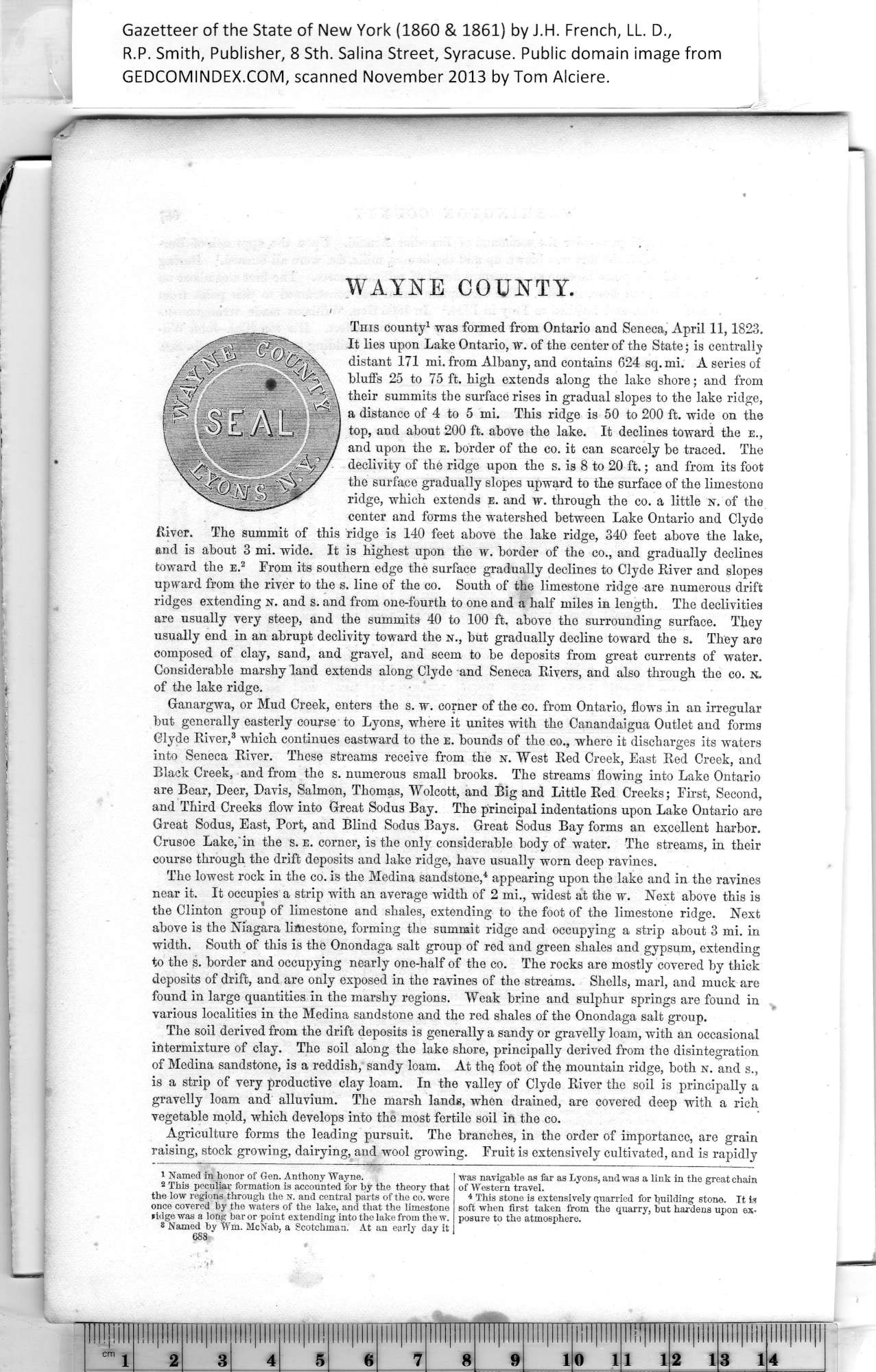|
WAYNE COUNTY.
This county1 was formed from Ontario and Seneca, April 11,1823.
It lies upon Lake Ontario, W. of the center of the State; is centrally
distant 171 mi. from Albany, and contains 624 sq.mi. A series of
bluffs 25 to 75 ft. high extends along the lake shore; and from
their summits tbe surface rises in gradual slopes to the lake ridge,
a distance of 4 to 5 mi. This ridge is 50 to 200 ft. wide on the
top, and about 200 ft. above the lake. It declines toward the e.,
and upon the e. border of the co. it can scarcely be traced. The
declivity of the ridge upon the s. is 8 to 20 ft.; and from its foot
the surface gradually slopes upward to the surface of the limestone
ridge, which extends E. and w. through the co. a little n. of the
center and forms the watershed between Lake Ontario and Clyde
River. The summit of this ridge is 140 feet above the lake ridge, 340 feet above the lake,
and is about 3 mi. wide. It is highest upon the w. border of the co., and gradually declines
toward the e.2 From its southern edge the surface gradually declines to Clyde River and slopes
upward from the river to the s. line of the co. South of the limestone ridge are numerous drift
ridges extending n. and s. and from one-fourth to one and a half miles in length. The declivities
are usually very steep, and the summits 40 to 100 ft. above the surrounding surface. They
usually end in an abrupt declivity toward the n., but gradually decline toward the s. They are
composed of clay, sand, and gravel, and seem to be deposits from great currents of water.
Considerable marshy land extends along Clyde and Seneca Rivers, and also through the co. n.
of the lake ridge.
Ganargwa, or Mud Creek, enters the s. w. corner of the co. from Ontario, flows in an irregular
but generally easterly course to Lyons, where it unites with the Canandaigua Outlet and forms
Clyde River,3 which continues eastward to the e. bounds of the co., where it discharges its waters
into Seneca River. These streams receive from the n. West Red Creek, East Red Creek, and
Black Creek, and from the s. numerous small brooks. The streams flowing into Lake Ontario
are Bear, Deer, Davis, Salmon, Thomas, Wolcott, and Big and Little Red Creeks; First, Second,
and Third Creeks flow into Great Sodus Bay. The principal indentations upon Lake Ontario are
Great Sodus, East, Port, and Blind Sodus Bays. Great Sodus Bay forms an excellent harbor.
Crusoe Lake, in the s. e. corner, is the only considerable body of water. The streams, in their
course through the drift deposits and lake ridge, have usually worn deep ravines.
The lowest rock in the co. is the Medina sandstone,4 appearing upon the lake and in the ravines
near it. It occupies a strip with an average width of 2 mi., widest at the w. Next above this is
the Clinton group of limestone and shales, extending to the foot of the limestone ridge. Next
above is the Niagara limestone, forming the summit ridge and occupying a strip about 3 mi. in
width. South of this is the Onondaga salt group of red and green shales and gypsum, extending
to the s. border and occupying nearly one-half of the co. The rocks are mostly covered by thick
deposits of drift, and are only exposed in the ravines of the streams. Shells, marl, and muck are
found in large quantities in the marshy regions. Weak brine and sulphur springs are found in
various localities in the Medina sandstone and the red shales of the Onondaga salt group.
The soil derived from the drift deposits is generally a sandy or gravelly loam, with an occasional
intermixture of clay. The soil along the lake shore, principally derived from the disintegration
of Medina sandstone, is a reddish, sandy loam. At the foot of the mountain ridge, both n. and s.,
is a strip of very productive clay loam. In the valley of Clyde River the soil is principally a
gravelly loam and alluvium. The marsh lands, when drained, are covered deep with a rich
vegetable mold, which develops into the most fertile soil in the co.
Agriculture forms the leading pursuit. The branches, in the order of importance, are grain
raising, stock growing, dairying, and wool growing. Fruit is extensively cultivated, and is rapidly
|
was navigable as far as Lyons, and was a link in the great chain
of Western travel.
* This stone is extensively quarried for building stone. It is
soft when first taken from the quarry, but hardens upon ex¬
posure to the atmosphere. |
1
Named in honor of Gen. Anthony Wayne.
2
This peculiar formation is accounted for by the theory that
the low regions through the ?r. and central parts of the co. were
once covered by tho waters of the lake, and that the limestone
3
»idge was a long bar or point extending into the lake from the w.
4
8 Named by Wm. McNab, a Scotchman. At an early day it
|
